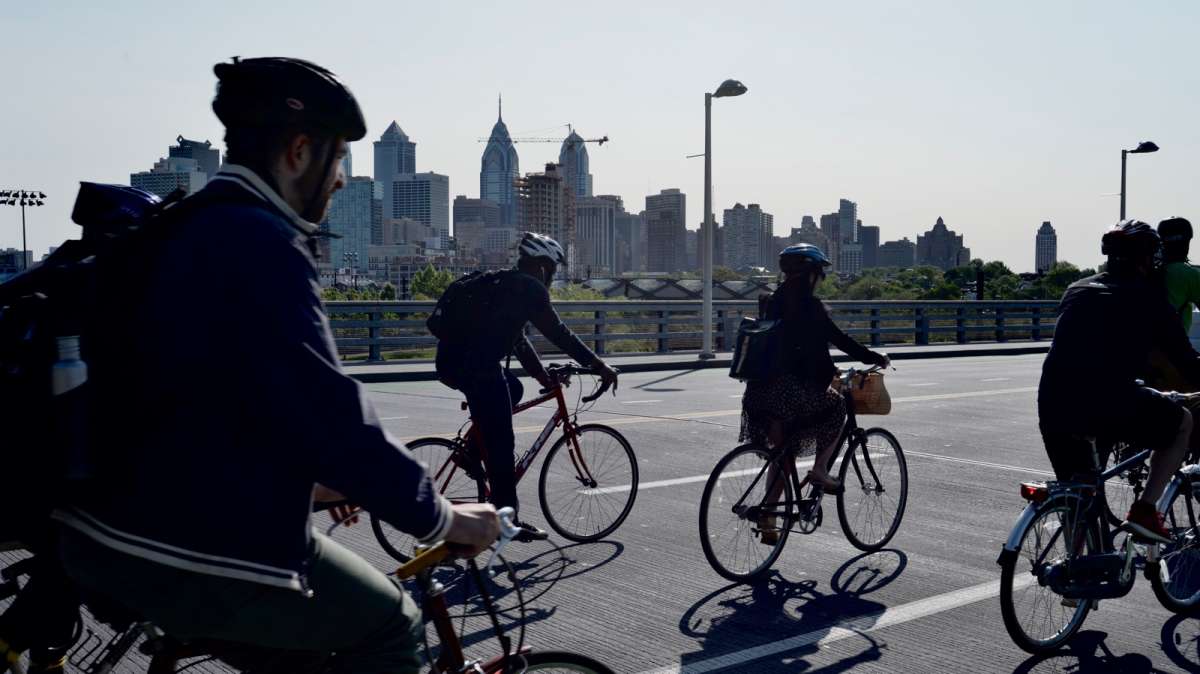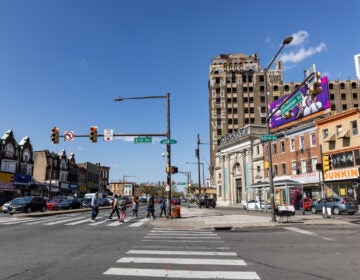Safer streets within reach in 2019
Randy LoBasso, policy manager at the Bicycle Coalition of Greater Philadelphia, looks forward to 2019 with hope for the safety of Philly streets.

Cyclists cross the South St. Bridge as they ride towards Center City on Bike to Work Day. (Bastiaan Slabbers for WHYY, file)
A veteran Philadelphia journalist once joked to me that a plan in Philadelphia is like raindrops in a storm. I’ve often tended to agree with him. Philadelphia does a ton of planning, often with little to show for it down the line.
But the city has likely hit a tipping point. As the latest U.S. Census data show, more people are biking in Philly than ever before. Subway use is up. Uber and Lyft have taken over ride-hailing — and cutting, deeply, into bus service. Online shopping has created an army of delivery trucks, wreaking havoc by sitting in streets and bike lanes. Bike sharing continues to flourish, and Indego recently added a fleet of e-bikes. It’s all led up to severely clogged city streets.
So, while Philadelphia may still do a lot of transportation planning, we’ve reached the point where, if those plans don’t actually lead to something, things are only going to get a lot worse.
Bike network
Mayor Jim Kenney made news at the Vision Zero Philadelphia Conference in March 2018 when he announced a new bike lane pilot project through JFK and Market Streets in Center City.
The Bicycle Coalition of Greater Philadelphia had long advocated for these bike lanes, noting they will not only help cyclists commute to their jobs, school, or wherever they need to go in Center City, but will also help calm traffic. That’s happened since they were installed. And these streets are part of the city’s planned 40 miles of protected bike lanes by 2025.
City Council still needs to pass an ordinance to solidify these lanes — then extend them to 30th Street Station. Doing so would improve access to Center City for multi-modal travelers.
2019 Goal: Make these lanes permanent. Extend to 30th Street Station.
In the spring, after years of conflicts, City Hall finally unveiled plans for making the highly-used bike lanes along Spruce and Pine Streets in Center City safer.
The biggest proposed change to Spruce and Pine was a planned switch of the bike lane from the right to the left. The city also plans to install green paint on those streets and protect the intersections, between 2nd and 22nd Streets. The proposals came after a series of public meetings, and the changes are welcome, but they do not go far enough to make sure everyone using these streets is safe.
2019 Goal: After these changes finally happen, push for better enforcement, better protection.
Another important corridor — 27th and South Streets in Southwest Center City, which respectively lead to and from the South Street Bridge — finally began receiving upgrades this year. Both streets are important for the safety of commuters traveling between the city’s two commercial hubs, University City and Center City, and their respective surrounding neighborhoods. After a Water Department project was completed in the fall, physical protection was supposed to be installed. As 2018 ends, it is still not done.
2019 Goal: Physical protections on South and 27th Streets.
Improvements on Philadelphia’s most dangerous streets
According to a Bicycle Coalition of Greater Philadelphia study of the city’s most collision-prone, “high-injury” corridors, nearly 50 percent of the roadways along the high-injury network are in impoverished communities of color. Many of the most dangerous streets within those communities — Lehigh, Allegheny, Olney, North 5th, North American, North 2nd — need to see real changes in the coming years.
Part of the responsibility for constructing the right safety changes to these streets lies with the Bicycle Coalition of Greater Philadelphia, AARP PA and PECO, who partnered with local community organizations in North and West Philadelphia throughout 2018, holding listening sessions where community members provided feedback on what they would like to see from a Vision Zero plan in their community.
It’s imperative to gather information on what residents want to see done there because we believe it’s essential the community have a say in what happens down the line. “The great thing about this Vision Zero alliance is that we’re going out into the communities,” De’Wayne Drummond, who has been facilitating the listening sessions, told PlanPhilly in December. “We’re not planning for the communities. We want the community to be part of this plan, not be planned for.”
The listening sessions will continue in 2019 and end with a public presentation at City Hall.
2019 Goal: City identifies new infrastructure projects along high injury network in North and West Philadelphia and begins implementing safer streets projects.
Speed cameras
A lot of ink has been spilled concerning this year’s legalization of speed cameras for Roosevelt Boulevard. As someone who took part in numerous trips to Harrisburg to lobby for the bill over the last couple years, I can tell you this: Even the most obvious solutions to the most pressing problems aren’t a given in the Pennsylvania State Capital.
In a typical year, more than 10 percent of all of Philadelphia’s annual road fatalities happen on the Boulevard, even though it represents just 0.6 percent of city streets.
In 2018, according to the most recent data, Roosevelt Boulevard has taken more lives than usual. Of the at least 88 total traffic deaths in Philadelphia this year, at least 15, 17 percent, happened on the Boulevard.
The Route For Change project, to re-engineer the Boulevard, is still in the planning process. And it’s going to take decades and billions of dollars to complete. So, in the meantime, street safety advocates all over Philadelphia worked for the next best thing: Automated enforcement to bring down fatalities. Long story short: The bill passed. But it still needs corresponding City Council legislation and has to be implemented by the City and Philadelphia Parking Authority.
2019 Goal: City Council passes enabling legislation, and speed cameras begin enforcing speeding drivers on Roosevelt Boulevard.
Bus network
Though subway ridership is thriving, bus ridership is way down in Philadelphia, and it’s no surprise why. Riding a bus along some of the city’s most dense areas can be slower than walking, given new levels of congestion, brought on by an onslaught of new citizens and ride-hailing services in Philadelphia.
So, SEPTA spent a good portion of 2018 creating a new vision for its bus system, including the elimination of transfer fees, all-door boarding, more-direct routes, stops on every other block in Center City (rather than every block). It’s all detailed in a 100-page blueprint titled “Philadelphia Bus Network Choices.”
The city and SEPTA also took a big step when it committed to enforcing the bus/bike lanes on Chestnut and Market Streets in Center City. For years, cyclists and bus riders have figured that “Bus Bike Only” paint on the street was a relic of times past, or maybe just a cruel joke. The PPA has even found that bus stops are blocked by people in cars about 2,000 times per day, citywide.
Unfortunately, the sort of enforcement needed to keep bus and bike lanes clear can’t really be done with police officers writing tickets. You need cameras on buses that have been utilized in other cities, which take pictures of the licenses plates of cars blocking the bus lanes, then send an automated ticket to the driver. Only that has been proven to work, and it’s what Philadelphia needs to make buses travel with increased efficiency.
2019 Goal: Implement changes recommended by the “Bus Network Choices” report. Lobby for, and win, new technology for SEPTA buses.
Fix loading zones
Congestion isn’t just happening because there are a lot of cars. It’s also because the boom in online shopping has given rise to more delivery trucks blocking streets and bike lanes. That’s why the Bicycle Coalition of Greater Philadelphia introduced an idea that would allow businesses to create more loading zones by waving loading zone fees for businesses on streets with bike lanes—giving delivery truck drivers legal curbside space to unload, rather than double parking.The idea was then introduced in late 2018 by Councilman Kenyatta Johnson. The bill did not move in 2018 — as it would likely have to be coupled with PPA’s blessing and a plan to increase parking violation fees, so the money flowing from the Parking Authority to the Philadelphia School District is not impacted. But in 2019, allowing easier creation of loading zones should be an easy win for the City.
2019 Goal: Improve the loading zone logjam.
WHYY is your source for fact-based, in-depth journalism and information. As a nonprofit organization, we rely on financial support from readers like you. Please give today.







